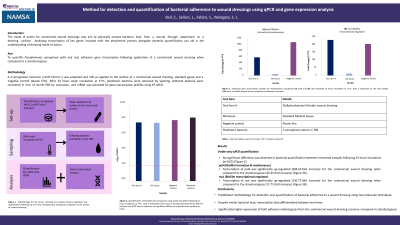Laboratory Research
(LR-002) Detection and quantification of bacterial adherence using qPCR
Friday, April 28, 2023
7:15 PM - 8:30 PM East Coast USA Time

Laura Sellars, PhD; Samantha Westgate, PhD
Introduction: The presence of bacteria in a wound can prevent wound healing and lead to chronic infections. Commercial wound dressings may aim to physically remove bacterial load from a wound through attachment to a dressing surface. Bound bacteria are then removed during the dressing change. With repeated applications, the bacterial load of the wound can be reduced to allow the immune system to fight the infection. In this study we analyzed key genes involved in the bacterial attachment process alongside bacterial quantification, to further understand the wound dressing mode of action.
Methods: A Pseudomonas aeruginosa inoculum was prepared and 100 µL were applied to the surface of a commercial wound dressing, standard gauze, and a positive control. Each sample was incubated for 24 hours at 37oC under static conditions.
Following incubation, 1 mL of planktonic bacteria were taken from each sample and the remaining bacteria were removed from the sample by washing in sterile PBS. Adhered bacteria were recovered in PBS and both DNA and mRNA were extracted for analysis using qPCR or RT-qPCR:
Results: Viable-only quantification of P.aeruginosa
No significant difference was detected in bacterial quantification between adhered samples and planktonic samples following 24 hours incubation (p > 0.05).
Transcription profiles of the pelA and rsaL genes
Statistical difference was detected in the pelA and rsaL genes between the commercial wound dressing and the gauze following 24 hours incubation (p < 0.05).
Discussion: These results demonstrated that despite a similar bacterial load, transcription data differentiated between test items making this a novel but simple method for detection and quantification of bacterial adherence to a wound dressing.
Methods: A Pseudomonas aeruginosa inoculum was prepared and 100 µL were applied to the surface of a commercial wound dressing, standard gauze, and a positive control. Each sample was incubated for 24 hours at 37oC under static conditions.
Following incubation, 1 mL of planktonic bacteria were taken from each sample and the remaining bacteria were removed from the sample by washing in sterile PBS. Adhered bacteria were recovered in PBS and both DNA and mRNA were extracted for analysis using qPCR or RT-qPCR:
Results: Viable-only quantification of P.aeruginosa
No significant difference was detected in bacterial quantification between adhered samples and planktonic samples following 24 hours incubation (p > 0.05).
Transcription profiles of the pelA and rsaL genes
Statistical difference was detected in the pelA and rsaL genes between the commercial wound dressing and the gauze following 24 hours incubation (p < 0.05).
Discussion: These results demonstrated that despite a similar bacterial load, transcription data differentiated between test items making this a novel but simple method for detection and quantification of bacterial adherence to a wound dressing.

.png)